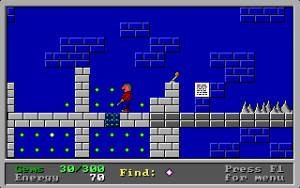Clyde’s Adventure 

Poor Clyde can’t catch a break. All he wants to do is collect gems, but some malevolent force keeps trapping him behind walls and making the floor disappear.
Your enjoyment of Clyde’s Adventure will vary with how much abuse you will accept. Clyde’s quest for treasure looks simple, plays more simply, and deals in a secret cruelty to the player that, while stimulating, might not be for everyone.
Clyde is a treasure hunter best described as a dad in a hoodie. He travels to sixteen castles to find a special artifact in each one, like a crown or a candlestick. (The story specifics about his quest to the land of Tahookaboo are totally inconsequential.) He has limited stamina, and to avoid tuckering out, you need to find extra energy and limit unnecessary walking or jumping. Occasionally, you’ll need to use his magic wand to dispel blocks to open a new path. Each castle also contains a few hundred gems, and if Clyde collects enough, more castles become available.
The straightforward concept, with its playful, bright style and sing-songy music, belies how nasty Clyde’s Adventure can be when it wants to. The castles sprawl in every direction and rarely present a direct route; sometimes you only need to plan an optimal path while exploring, but otherwise you must activate secret passageways to reach the treasure. When you pull a lever, or when a hint directs you to an invisible magic spot, something in the level changes. Maybe a new platform appears, or an electrical barrier shuts down. Anything can happen, for better or worse.
Clyde’s Adventure frequently uses these expectations to punish you in random, embarrassing ways. The game tries to warn you about upcoming funny business, but the castles are rife with unpleasant surprises. Basically, anything can trick or confuse you, usually followed up with a teasing comment. If Clyde walks down a narrow passage, it could seal behind him. A group of vanishable blocks can reveal gems, bombs, or just dead ends. Teleporters are potential death wishes if you don’t know where they lead. Frankly, it’s pretty funny, since the game anticipates how you’ll move through the levels and taunts you at the right times (the first castle slaps your wrist for using the magic wand too early).
Clyde looks constantly, hilariously bemused, like he’s totally over the game toying with him. How much you like Clyde’s Adventure depends on whether you react that way too. At its best, Clyde’s Adventure lets you in on the fun of its connivery; good-natured mocking from a difficult level can inspire you to give it another shot. But restarting a castle after so many failures becomes demoralizing if it stops being interesting. Yet another gem-filled trap may wear on your patience.
The game has a playful attitude, and it expresses that like a roughhousing friend who doesn’t understand that they’re probably hurting you. Should you find satisfaction in pushing back against (or enduring) that sort of behavior, Clyde’s Adventure has a dozen or so castles for you to plunder.
Trivia!
A second, paid episode of Clyde’s Adventure,”The Vanished King,” includes another similar sixteen levels. The game also has a sequel, Clyde’s Revenge, the title of which seems more direct about the difficulty.


